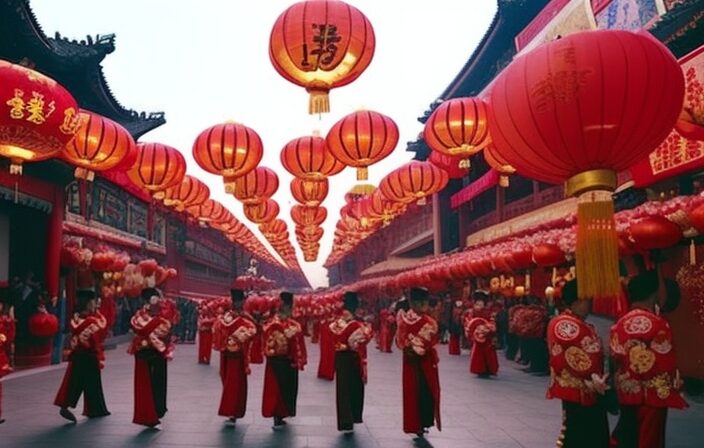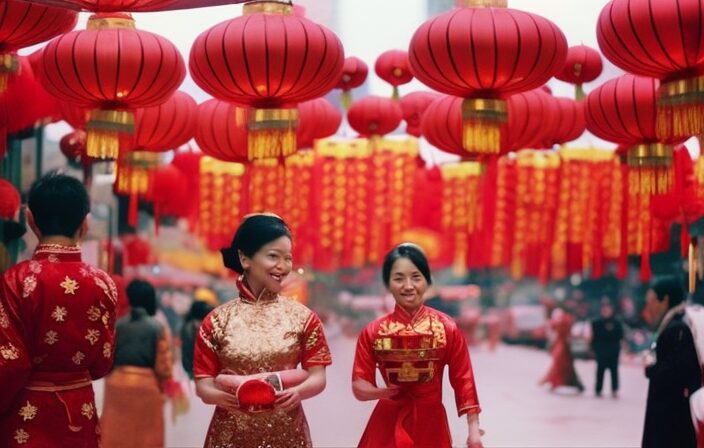Experience the rich tapestry of Lunar New Year celebrations across the diverse regions of China.
From the ancient customs of Xi’an to the modern twists in Hong Kong and Macau, each region offers its own unique charm and traditions.
Immerse yourself in the vibrant festivities of Beijing and its surrounding areas, explore the southern delights of Guangzhou, and marvel at the coastal charm of Shanghai.
Join us on a journey through China as we delve into the colorful and diverse Lunar New Year celebrations.
Key Takeaways
- Regional Lunar New Year celebrations take place in various cities and areas of China, including Beijing, Guangzhou, Shanghai, Xi’an, and minority regions.
- Traditional Lunar New Year celebrations in China involve customs and rituals, lion and dragon dances, red lanterns and decorations, fireworks displays, and family gatherings and feasts.
- Ethnic traditions are an important part of Lunar New Year festivals, showcasing unique costumes, performances, music, dance, food, and facilitating cultural exchange and appreciation.
- Modern twists can be seen in Lunar New Year celebrations, particularly in Hong Kong and Macau, where there is a fusion of tradition and innovation, highlighted by events like the International Chinese New Year Night Parade and cultural performances.
Northern Traditions: Celebrating Lunar New Year in Beijing and Surrounding Areas
Lunar New Year in Beijing and its surrounding areas is marked by distinct northern traditions and customs. The celebration of the Lunar New Year, also known as Spring Festival, is a time when families come together to celebrate and welcome the new year.
One of the highlights of the Lunar New Year in Beijing is the northern cuisine that is enjoyed during this festive season. Traditional dishes such as jiaozi (dumplings) and niangao (sticky rice cake) are prepared and shared amongst family members. These dishes symbolize good luck and prosperity in the coming year.
In addition to the culinary delights, cultural performances are an integral part of Lunar New Year celebrations in Beijing. The famous Temple Fair, held in parks and temples across the city, showcases traditional Chinese arts and performances. Visitors can witness mesmerizing dragon and lion dances, acrobatic shows, and traditional music and dance performances. These cultural displays not only entertain the crowds but also provide a glimpse into the rich cultural heritage of Beijing.
Overall, Lunar New Year celebrations in Beijing and its surrounding areas are a blend of traditional customs, delicious northern cuisine, and vibrant cultural performances. It is a time when families gather, share festive meals, and partake in various cultural activities. The combination of these elements creates a unique and memorable experience for all those who participate in the Lunar New Year festivities.
Southern Delights: Exploring Guangzhou’s Vibrant Lunar New Year Celebrations
Guangzhou’s vibrant Southern Delights offer a unique perspective on the annual festivities during the Chinese New Year period. Known for its rich culinary traditions, Guangzhou’s cuisine takes center stage during this time of celebration. The city’s famous dim sum restaurants are filled with families indulging in delectable dumplings and steamed buns, symbolizing prosperity and good fortune for the coming year.
In addition to its mouthwatering cuisine, Guangzhou also showcases a variety of cultural performances during the Lunar New Year celebrations. The streets come alive with vibrant lion and dragon dances, as performers dressed in colorful costumes parade through the city, accompanied by the rhythmic beat of drums and cymbals. These performances are believed to bring luck and ward off evil spirits, creating an atmosphere of joy and excitement.
One of the highlights of Guangzhou’s Lunar New Year celebrations is the Flower Fair, held in Yuexiu Park. Here, visitors are treated to a dazzling display of flowers, including blooming plum blossoms, symbolizing resilience and perseverance. The fair also features traditional music and dance performances, adding to the festive ambiance.
Guangzhou’s Southern Delights during the Lunar New Year period offer a wonderful blend of gastronomic delights and cultural experiences. It is a time when locals and visitors alike come together to celebrate, indulge, and immerse themselves in the vibrant spirit of the city.
Coastal Charm: Lunar New Year Festivities in Shanghai and Coastal Regions
Shanghai and the coastal regions of China come alive with vibrant festivities during the annual Chinese New Year period, showcasing a unique blend of cultural traditions and coastal charm.
In Shanghai, the waterfront festivities are a sight to behold. The iconic Bund, with its stunning skyline and historic buildings, becomes a hub of activity. Colorful lanterns adorn the streets, while traditional lion and dragon dances captivate the crowds. Fireworks light up the night sky, symbolizing good luck and warding off evil spirits. The bustling markets offer a variety of traditional snacks and delicacies, such as tangyuan and niangao, which are enjoyed by locals and tourists alike.
Coastal cuisine plays a significant role in the Lunar New Year celebrations in these regions. Fresh seafood, such as fish, crabs, and prawns, are featured prominently on the dining tables. The coastal communities believe that consuming seafood during this auspicious time brings prosperity and good fortune for the year ahead. Furthermore, various seafood-based dishes are prepared using traditional recipes passed down through generations, adding a unique flavor to the festivities.
The coastal regions also have their own set of traditions during Chinese New Year. Fishing communities engage in rituals to pray for a bountiful catch and safe voyages for the fishermen. Local customs, such as the throwing of oranges into the sea or the release of paper lanterns, are believed to bring good luck and ward off evil spirits. These coastal traditions add an extra layer of charm to the celebrations, offering a glimpse into the rich cultural heritage of these regions.
Ancient Customs: Traditional Lunar New Year Celebrations in Xi’an and Historic Areas
Xi’an and its historic areas are steeped in ancient customs that are deeply intertwined with the traditional celebrations of the Chinese New Year. As the capital of Shaanxi Province in central China, Xi’an boasts a rich cultural heritage that is reflected in its Lunar New Year festivities.
One of the most prominent traditional customs in Xi’an is the Temple Fair, held in the city’s ancient temples. During the fair, locals and tourists alike gather to enjoy performances of traditional music and dance, taste local delicacies, and participate in traditional games and activities. The fair provides a unique opportunity to experience the vibrant atmosphere and immerse oneself in the local culture.
Another notable custom is the practice of making and displaying paper cuttings. These intricate designs, often depicting scenes of good fortune and prosperity, are believed to bring luck and ward off evil spirits. The streets of Xi’an are adorned with these colorful paper cuttings, creating a festive and auspicious ambiance.
In addition to these customs, Xi’an residents also observe traditional customs such as cleaning the house to sweep away bad luck, offering sacrifices to ancestors, and setting off firecrackers to drive away evil spirits. These age-old traditions are deeply rooted in the cultural heritage of Xi’an and are cherished by the locals.
Ethnic Diversity: Lunar New Year Festivals in Minority Regions of China
The ethnic diversity of China is showcased through the various festivals held in minority regions during the traditional spring festival period. These festivals not only celebrate the Lunar New Year but also highlight the rich ethnic traditions and cultural diversity of China.
In Yunnan province, the Bai people celebrate the Lunar New Year with their unique customs and rituals. The Bai New Year Festival, known as ‘Saga Dawa,’ features grand processions, traditional dances, and performances that showcase their vibrant culture. The festival also includes religious ceremonies, where the Bai people pay homage to their ancestors and seek blessings for the coming year.
Similarly, in Guizhou province, the Miao ethnic group celebrates the Lunar New Year with the ‘Kaihe’ festival. During this festival, the Miao people dress in colorful traditional costumes and perform traditional dances, such as the ‘Lusheng Dance’ and the ‘Sister’s Meal Dance.’ These dances are accompanied by the rhythmic beats of drums and the melodious sounds of lusheng, a traditional wind instrument.
These festivals not only offer a glimpse into the diverse ethnic traditions and cultural heritage of China but also provide an opportunity for people from different backgrounds to come together and celebrate the spirit of the Lunar New Year.
Modern Twists: Contemporary Lunar New Year Celebrations in Hong Kong and Macau
As Lunar New Year celebrations continue to evolve, Hong Kong and Macau have embraced a contemporary fusion in their festivities. These vibrant cities have put their own unique spin on the traditional customs and rituals, creating a captivating and modern experience for locals and tourists alike.
In Hong Kong, the Lunar New Year celebrations showcase a blend of tradition and innovation. One of the highlights is the iconic International Chinese New Year Night Parade, where colorful floats, mesmerizing performances, and dazzling fireworks light up the streets. This modern twist on the traditional lion and dragon dances adds an element of excitement and spectacle to the festivities.
Macau, known for its vibrant blend of Chinese and Portuguese cultures, also offers a contemporary take on Lunar New Year celebrations. The city hosts a series of cultural performances that showcase a fusion of traditional Chinese arts and modern interpretations. From acrobatic shows to contemporary dance performances, Macau’s Lunar New Year festivities display a vibrant mix of old and new.
These contemporary Lunar New Year celebrations in Hong Kong and Macau not only provide a platform for cultural exchange but also attract visitors from around the world. By incorporating elements of modernity into their traditions, these cities have successfully preserved their cultural heritage while embracing the spirit of innovation.
How Have the Lunar New Year Celebrations in Different Regions of China Evolved Over Time?
The evolution of lunar new year celebrations in different regions of China reflects a rich tapestry of customs and traditions. From the lion and dragon dances in southern China to the lantern festivals in northern China, each region has its unique way of commemorating this auspicious occasion. Over time, these celebrations have embraced modern influences while still preserving their ancient roots, illustrating the ever-changing dynamics of Chinese culture.
Conclusion
In conclusion, Lunar New Year celebrations in China offer a diverse range of traditions and customs across different regions. From the northern traditions in Beijing to the vibrant festivities in Guangzhou, each area has its own unique way of welcoming the new year.
With coastal charm in Shanghai, ancient customs in Xi’an, ethnic diversity in minority regions, and modern twists in Hong Kong and Macau, Lunar New Year in China is a truly remarkable and culturally rich celebration.
It is estimated that over 1.4 billion people in China participate in Lunar New Year festivities, making it one of the largest and most important cultural events in the country.



